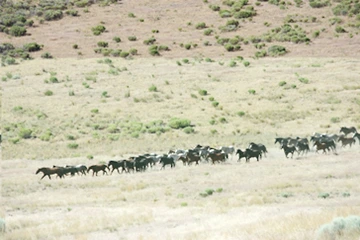
Figure 1. Wild horses in Owyhee Horse Management Area, Nevada, USA.
Betsy Greene
Few images of the West are more iconic than a herd of wild horses galloping across the landscape. The Wild Free-Roaming Horses and Burros Act of 1971 ensured these images would continue as living symbols of the historic and pioneer spirit of the West. As cultural icons of the West, wild horses hold great emotional significance, often eliciting heated debates and litigation over how these animals should be managed (Kaweck et al. 2018). The goal of protecting wild horses and burros while managing them to achieve a thriving natural ecological balance has challenged the Bureau of Land Management (BLM) and US Forest Service (USFS) Wild Horse and Burro Programs since their inception (NRC 2013). Often, the general public is not aware of the complex factors that go into managing U.S. public lands. One primary factor that is frequently misunderstood is that access to most public lands is federally mandated and includes all groups, including the public, ranchers, timber harvesters, native animals, feral horses, etc. Additionally, few understand that the BLM and USFS are required by law to manage public lands to sustain a healthy environment for multiple uses, including horses and burros. The goal of this article is to summarize key factors concerning horse and burro management on public lands to increase our understanding of the many challenges involved.
Federal Protection of Wild Horses and Burros
Wild horses and burros (WHB) are currently protected under the Wild Free-Roaming Horses and Burros Act of 1971 (WHB Act; Public Law 92–195). This Act protects unbranded or unclaimed WHB on select public lands from being captured, branded, harassed, or killed. The Act authorizes the Bureau of Land Management (BLM) and Forest Service (USFS) to provide habitat for WHB in areas where they existed on public lands in 1971. Both agencies must manage WHB at a ‘minimum feasible level’ to maintain their wild status. This means that, unlike livestock, it is difficult to control when, where, or how long WHB may graze within (or outside of) a designated management area. Additionally, because federal public lands are managed to sustain multiple uses (What are Public Lands and who are they for? - see below), the BLM and USFS are mandated to manage WHB in a way that maintains a ‘thriving and natural ecological balance’ on the landscape.
Why are Wild Horses and Burros protected?
To appropriately answer this question, a brief history of western public lands is required. After the U.S. government gained control of western lands, the lands owned by the federal government (e.g., public lands) were governed under a ‘commons’ system where individuals shared use of these lands. Over time, the commons system led to competition among multiple interests (cattle, sheep, local, and transient operators) competing with one another in a “race for feed” which resulted in poor rangeland conditions from overstocking and excessive grazing impacts known as the “tragedy of the commons” (Hardin 1968).
To limit rancher conflict and improve rangeland health, Congress passed the Taylor Grazing Act in 1934 (Public Law 73-482). This Act installed a system of grazing districts and a grazing permit system on public lands that allowed ranchers to obtain leases or permits from the government to graze their livestock based upon priority use (1929-1934), base property production, and public land carrying capacity. With ranchers now having more control over specific grazing allotments, they also had more accountability to sustainably manage land under their lease or permit. The BLM initiated an “adjudication” period in the mid-1950s to mid-1960s to survey and establish the carrying capacity of public lands being grazed under lease. This adjudication period began the determination of our public land's carrying capacity that could sustainably support livestock and wildlife. However, feral horses were not considered livestock or wildlife and became increasingly viewed as pests by land and wildlife management agencies now responsible for the sustainable management of public lands and wildlife habitat, and as competition to the ranchers' dependent upon public lands for grazing. During World War II, free-roaming domestic and feral equids were rounded up for use in the military cavalry and domestic and foreign meat markets. Following the war, feral horses were gathered and processed into commercial pet food (Sowell et al 1983). Post-World War II, feral horses and burros remaining on public lands that were not owned or claimed, were captured and removed in significant numbers through a process known as ‘mustanging’ (Godfrey and Lawson 1986) which involved hunting and/or capturing feral horses and burros, using airplanes, trucks, pit traps, and poisoned water holes.
By the 1950s, feral populations had decreased significantly, and the capture methods employed by mustangers impelled Velma B. Johnston of Reno, Nevada, later known as "Wild Horse Annie," to protect these animals. She organized a letter-writing campaign, known as the “Pencil War,” to bring attention to the inhumane methods implemented to gather feral horses and burros (Burkhardt 2024). In response, Congress passed the Wild Horse Annie Act (Public Law 86- 234) to ban the use of motorized vehicles and the poisoning of water sources to hunt, capture, or kill feral horses and burros on public lands. However, this act did not include Wild Horse Annie’s recommendation that Congress initiate a program to protect, manage, and control feral horse and burro populations. Public interest and concern continued to gain momentum until Congress eventually passed the WHB Act in 1971. Ironically, Mrs. Johnston later expressed how she may have unintentionally “started something that has gotten out of control” and condemned many of the advocacy groups and provisions in the WHB Act. She believed that unmanaged WHB populations would lead to inhumane suffering and death of her beloved WHBs from starvation and thirst (Burkhardt 2024).
Are Wild Horses and Burros “native” to the United States?
This is a tricky question because horses and burros are part of the Equidae family which arose in North America about 4 million years ago. However, likely due to a combination of climate change and hunting, all equid species became extinct on the continent during the last Ice Age roughly 12,000 years ago (Grayson 2007). For several thousand years, between the Ice Age and the European discovery of North America, horses were absent from the continent until Christopher Columbus brought domesticated horses with him on his second voyage in 1493 (Cortés et al. 2016). Soon after, Spanish conquistadors brought more horses and burros to Mexico and what is now the southwestern U.S. Over time, domestic horses and burros escaped, or were intentionally let loose, and feral populations became well-established (Wild, native, free-roaming, or feral - see below). Between the 1600s and early 1900s feral horses and burros were abundant across much of the West. With the onset of the Industrial Revolution in the late 1800s, horses and burros, once integral to modern civilization, became less needed for transportation, agriculture, and other needs. Consequently, more unneeded horses were released into the wild.
Where are Wild Horses and Burros located?
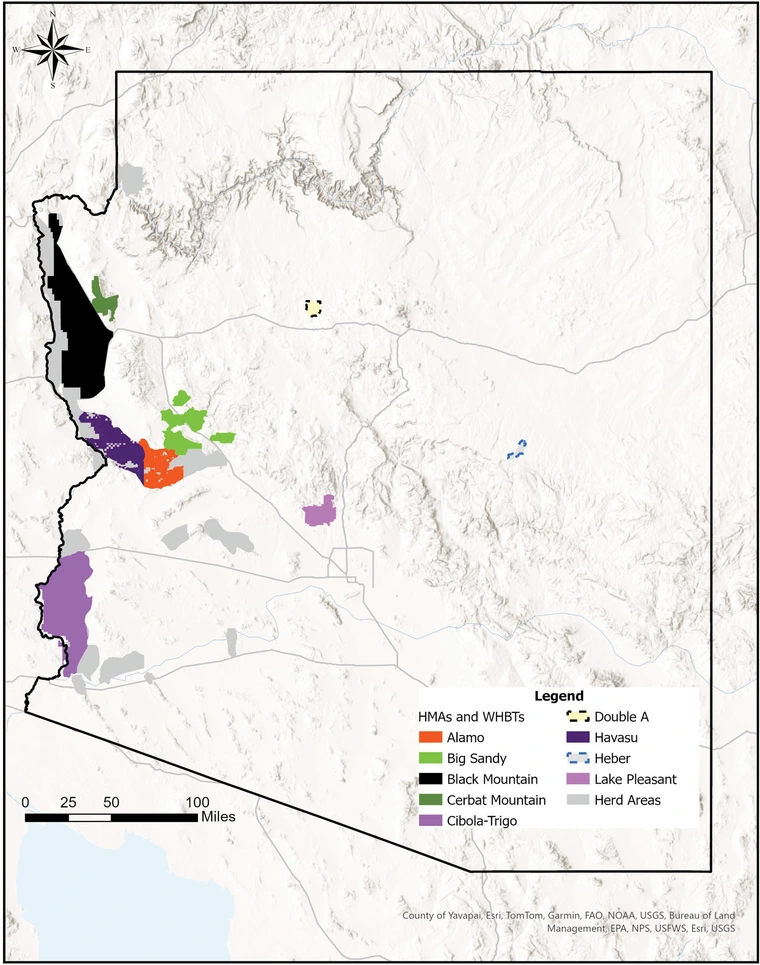
Figure 2. Location of Bureau of Land Management Herd Management Areas (solid colors) and US Forest Service Wild Horse and Burro Territories (dashed lines) within Arizona. Map also includes BLM Herd Areas (grey polygons), which are areas where WHB may exist but are not managed for as part of the multiple-use concept.
County of Yavapai, Esri, TomTom, Garmin, FAO, NOAA, USGS Bureau of Land Management, EPA, NPS, USFWS, Esri, USGS
Locations where WHB existed on public lands when the WHB Act was passed in 1971 are known as Herd Areas. However, Herd Areas are not currently managed for WHB populations as part of the multiple-use concept. Areas where WHB must be explicitly managed according to the 1971 WHB Act are known as Herd Management Areas (HMA) on BLM lands and Wild Horse and Burro Territories (WHBT) on USFS lands. Currently, there are 177 HMAs spread across 10 states with a total acreage of 31.6 million acres (BLM 2024). The USFS manages 53 Wild Horse and Burro Territories in 9 states, but only 34 of these currently have WHB populations (USFS 2014).
In Arizona, the BLM manages 7 HMAs while the USFS has jurisdiction over 2 WHBTs (Fig. 2). Arizona is home to the largest population of burros of any state (BLM 2024) where 5 of the 7 Arizona HMAs are solely managed for burros (Table 1). The USFS territories are the Heber (Apache National Forest) and Double A (Kaibab National Forest). The Heber is managed for horses while the Double A is managed for burros.
How many Wild Horses and Burros are there?
WHB populations quickly rebounded after the passage of the WHB Act in 1971, so much so that the act was further amended by the Public Rangelands Improvement Act (PRIA) of 1978 (Public Law 95–514). This act was established to improve rangeland conditions, but it was also implemented to manage the high cost of administering the WHB Act. This legislation recognizes that overpopulated WHB ‘pose a threat to their own habitat, fish, wildlife, recreation, water and soil conservation, domestic livestock grazing, and other rangeland values.’ This Act requires the BLM and USFS to determine appropriate management levels (AML) within horse and burro management areas. AML is a population size range of WHB set to achieve healthy WHB herds while simultaneously allowing sufficient forage for livestock and wild animals. Currently, WHB numbers exceed AML in every state except Idaho (Table 2). Across most states population sizes are 2-5 times the maximum AML (Table 2). Nationally, the maximum AML is 26,785 (BLM 2024), but national population size estimates are nearing 59,000 horses and over 14,000 burros, or approximately 275% of the maximum AML (Table 2). The current Arizona population sizes of WHB on BLM land are about 366% of the maximum AML. Recent estimates of populations are not currently available for WHB on USFS lands.
Ecological issues with overabundant Wild Horses and Burros
All rangelands have a carrying capacity, which is the average number of wildlife and/or livestock that may be supported within a management unit compatible with the management objectives for the unit (Bedell and SRM, 1998). When there are too many hooves on the ground in the same general location for too long of a time, regardless of species, damage to vegetation communities and related rangeland resources can occur. For example, feral horses and domestic cattle are both implicated in degrading riparian areas. However, horses may have a greater impact on riparian areas than cattle because horses often have year-round access to these areas, while cattle are generally removed for part of the year and oftentimes during growing seasons (Kaweck et al. 2018). Wild horses and burros differ from livestock and wildlife in a few other key ways that make them more likely to negatively impact natural resources.
Cattle, sheep, and most native ungulates (hooved mammals including deer, elk, bighorn sheep, and pronghorn) are ruminants (Janis 1976). This means they have a 4-chambered stomach containing a fermentation chamber where bacteria break down forage into energy for the animal. This chamber is located before the small intestines, which helps a ruminant obtain as much energy from their forage as possible (Fig. 3). Horses and burros are ungulates but are not ruminants; instead, they are considered hindgut fermenters because their fermentation chamber, called a cecum, lies after the small intestine (Fig. 3). This means that WHBs are less efficient in obtaining energy from their forage than a ruminant (Janis 1976). Hindgut fermenters are also less efficient in water retention (Janis 1976). These two factors mean that a WHB must eat and drink more to sustain themselves than a comparatively sized cow or elk. Second, WHB possess upper and lower incisors while ruminants only have lower incisors and an upper dental pad (Fig. 4; Scasta 2014). This allows WHB to clip vegetation closer to the ground than livestock and native ungulates. Thus, WHB grazing methods can limit the regrowth of vegetation because the growth points (i.e., meristems) of grasses occur close to the ground.
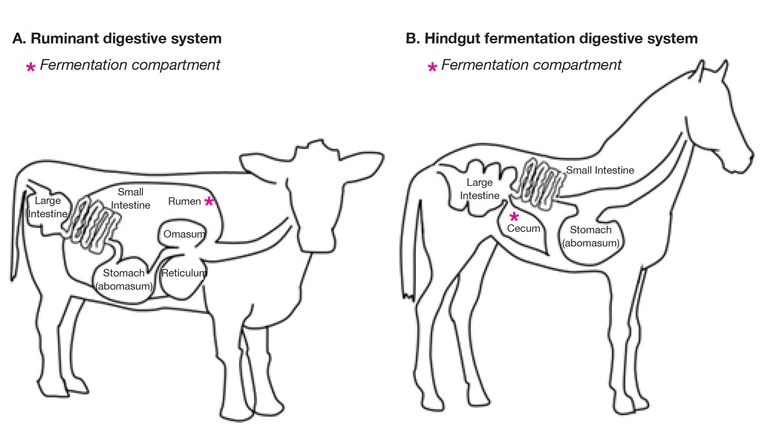
Figure 3. Comparison of digestive systems between a ruminant (cow), and hindgut fermenter (horse). Note that the main fermentation chamber of the cow (rumen) is located before small intestines, while the fermentation chamber of the horse (cecum) lies after the small intestines.
Figure adapted from Scasta (2014)
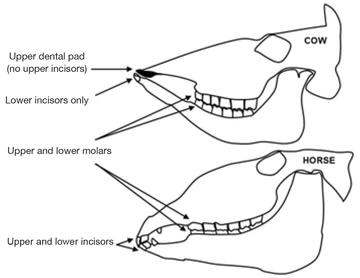
Figure 4. Comparison of dental morphology between a ruminant (cow), and a horse. Note that ruminants do not possess upper incisors, instead they have an upper dental pad.
Figure adapted from Scasta (2014)
A wide body of research shows that when the grazing impacts of WHB are not properly managed they adversely impact western rangelands. For instance, areas in the Great Basin that were exposed to unmanaged horse grazing had lower forage quantity, plant heights, and native plant diversity than similar sites where horses were removed or excluded (Beever et al. 2003, 2008, Davies et al. 2014, Boyd et al. 2017). Additionally, overgrazing by horses may lead to an increase in invasive species, more exposed bare soil, and increased soil compaction (Ostermann-Kelm et al. 2009, King et al. 2019, Hennig et al. 2021). These effects combine to increase erosion rates, degrade rangeland quality, and reduce carrying capacity.
In addition to their effects on vegetation and soil, WHB can also affect the animals they share the land with, especially at watering sites. Water is a precious resource in semi-arid western rangelands, and horses have been shown to actively exclude wild and domestic ungulates from watering holes (Perry et al. 2015). In California, bighorn sheep avoided preferred watering sites when horses were nearby (Ostermann-Kelm et al. 2008). Pronghorn in Nevada spent more time being vigilant and less time eating or drinking near water sources when horses were present (Gooch et al. 2017). In Utah, both pronghorn and mule deer altered which watering sites they used and when they visited them to limit interaction with horses (Hall et al. 2018). Also in Utah, the presence of horses at watering sites resulted in less native plant diversity compared to water holes where horses were excluded (Hall et al. 2016). A recent study showed that in HMAs where horse numbers were consistently above AML, the population sizes of greater sage-grouse declined over time compared to sites that were within AML (Coates et al. 2021).
How are population sizes obtained?
Accurate estimates of WHB are crucial to the management of these animals and their habitat. Ideally, a census would count every animal that occupies an area. However, conducting a true census of any wild animal population is extremely challenging across large, rugged landscapes, such as our Arizona rangelands. Currently, the BLM and USFS use aerial surveys to estimate the number of WHBs present with HMAs. Perfect detection of WHB (or any other animal species) is rarely accomplished; thus, agencies implement survey methods used to estimate the number of animals missed. The main method that the BLM uses is the Simultaneous Double-Observer method (Lubow and Ransom 2016). This method involves flying an aircraft, typically a helicopter, along transects laid out across the management area. Observers within the aircraft independently detect WHB groups and record variables known to influence detection probability. The data are statistically analyzed to generate a population estimate. However, this method often underestimates the true population sizes of WHB, particularly burros (Hennig et al. 2022). Recently, researchers have been working on methods to provide more accurate estimates of WHB (Hennig et al. 2022, Hennig and Schoenecker 2023).
What does the federal government do when there are too many horses and burros?
When survey data indicate that an HMA is above its maximum AML and damage is being caused to the range, the BLM and USFS will conduct a gather to remove ‘excess’ animals (Greene et al. 2011a, Greene et al. 2011b, Heleski et al. 2011). Gathers are typically performed by private, commercial contractors using helicopters to drive animals into temporary traps. Another method used to gather horses and burros is bait-trapping, which involves luring animals into holding pens with food or water. In Arizona, bait trapping is the preferred method of catching animals due to lower costs and the lack of access to equipment needed for helicopter gathers. After the animals are gathered, the agency transports the removed animals to short-term BLM holding facilities where they are assessed by a veterinarian, receive vaccinations, and prepared for placement into private care through an adoption program. Animals that are not adopted are offered as sale animals (not for commercial purposes) or placed in contracted off-range pastures. The BLM contracts with private landowners, primarily in the midwestern U.S., to have these animals graze on their lands until the end of their natural life.
Fertility control is another method federal agencies implement for controlling WHB population sizes, but it is not yet an effective method for long-term control. Currently, 3 fertility control vaccines are federally approved for use in WHB populations. The most effective vaccine can prevent pregnancy for up to 4 years, but only if the female receives a second dose 1-2 years following the first (Bechert et al. 2022). This can be hard to accomplish since WHB either need to be gathered, treated, and released, or staff must find WHB on the range and administer the vaccine with dart guns. Finding WHB in remote, rugged, and vast rangelands is difficult in the first place, not to mention that staff must get close enough (~30 yards) to the often-wary animals for the dart to penetrate the hide (Gedir et al. 2021). Fertility control measures can successfully slow population growth, but a large proportion of females within a herd need to be vaccinated to reduce or at least maintain population growth (Garrott 1991). Some have suggested that the best use of fertility control on WHB populations would be for the BLM to remove enough individuals to get within AML in each HMA, and then administer fertility control to the remaining individuals (Garrott and Oli 2013). Ongoing research is underway to find more effective fertility control methods (BLM 2024).
If the federal government is mandated to control Wild Horse and Burro populations, why are they overabundant?
Wild Horse and Burros have high reproductive rates which, combined with few natural predators, can cause populations to grow by 15-20% annually (NRC 2013). In other words, if the BLM conducts a removal gather, they usually must perform another gather every 3-5 years just to keep the population within AML. The keyword in the previous sentence is “if.” The WHB Act contains conflicting language stating the animals should be protected and only managed minimally; but it also states that the BLM and USFS should remove excess animals. This has led to the BLM being sued for both managing the animals too much and not enough, with both sides prevailing (Scasta et al. 2018). Furthermore, the National Environmental Protection Act (NEPA) of 1969 (Public Law 91-190) mandates that any federal management action is subject to public comment which can slow down or even stop removal gathers.
When the BLM is permitted to remove animals, the cost of doing so is expensive. In 2023, removal gathers cost the BLM $5 million to remove 5,335 animals. Keep in mind that this was only 10% of the total number of excess animals (BLM 2024). A significant impediment for the BLM to remove all excess animals is the high cost of caring for the animals they have previously removed but could not adopt or sell. Currently, approximately 62,000 horses are living in off-range holding pastures – 23,000 in short-term corrals and 39,000 in long-term, private pastures. The BLM pays the owners of these pastures to provide for the horses. Last year, the BLM Wild Horse and Burro Program spent $108 million, or 69% of its yearly budget, on off-range animals. In 2013, a study projected that by the year 2030, the BLM will have spent $1 billion on off-range horses (Garrott and Oli 2013). Currently, the agency is on track to surpass that number (Fig. 5). The off-range pastures are near capacity (BLM 2024), so unless adoption rates dramatically increase or the BLM can contract with more private landowners, their ability to remove excess on-range animals is limited.
The cost of horse and burro management on USFS lands is a different economic issue. The WHB Act did not allocate money to the BLM or USFS to manage the animals they are responsible for managing. Eventually, the BLM’s Wild Horse and Burro Program was created and receives annual funding to manage the animals (CRS 2022). In contrast, the USFS does not receive annual funding specific to managing WHB. This means that to perform any management activities, the USFS must take money from other programs or ask for monetary help from the BLM (National Wild Horse and Burro Advisory Board 2024).
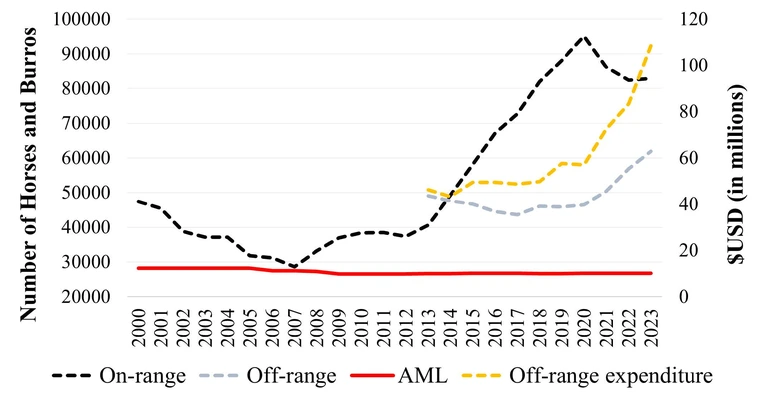
Figure 5. Number of wild horses and burros on BLM lands (on-range), number of horses and burros in off-range care, the national maximum appropriate management level (AML), and annual off-range expenditures by the BLM since the year 2000.
Figure adapted from Hennig et al. (2023)
Comparing the management of Wild Horse and Burros to livestock and native wildlife
The issues with WHB management in the United States are more challenging compared to managing livestock and wild ungulates. Livestock grazing permits on federal land are largely administered by the BLM and USFS (BLM 2020). To ensure long-term rangeland health, livestock grazing is managed by regulating livestock numbers (i.e., animal units), along with timing, duration, and intensity of use (BLM 1997). Accordingly, federal grazing permits for livestock place allotment-specific restrictions on season(s) and duration of use, number of animals, and type of livestock allowed within the permitted area or allotment. BLM and USFS staff monitor rangeland conditions and adjust grazing management decisions in response to the combined impacts of grazing by domestic and wild ungulates, fire, drought, and market conditions (BLM 2020). Conversely, WHB grazing is not managed for timing, duration, or intensity, nor is AML adjusted in response to rangeland conditions.
Unlike WHB, wild native ungulate populations are managed by individual states in accordance with the North American Wildlife Conservation Model (Mahoney 2004). This model states that wild vertebrates are reserved for the noncommercial use of individuals and are to be managed in a way that promotes sustained populations (Mahoney 2004). State wildlife agencies administer hunts to optimize population levels. These agencies use information from previous hunt statistics, sportsmen's comments, and results of habitat monitoring to implement hunting protocols (NDOW 2024). Like livestock grazing, protocols are put in place to manage the timing, intensity, and duration of hunting pressure to achieve population goals (NDOW 2024). Also, like livestock grazing, state agencies generate revenue for management actions by selling hunting licenses and harvest tags (Mahoney 2004). Lastly, both livestock and wild ungulate management is routinely informed through research projects (e.g. Sawyer et al. 2012, Northrup et al. 2016). Comparatively, there is little understanding of WHB ecology, and existing research has had minimal impact on WHB management (Hennig et al. 2018, 2023).
Summary
Both the BLM and USFS are mandated to manage public lands for multiple use and sustained yield of natural resources, and to balance all of these uses so that no one use degrades the ability of another. On select BLM and USFS lands, WHB populations and habitat are considered just one of many multiple uses. The multiple-use concept aims to have public lands utilized in a combination that will best meet the present and future needs of the American people. The portrayal of wild horses as the essence of America’s Wild West heritage, from old John Wayne movies to present-day social media avenues, can be somewhat myopic or tunnel-visioned relative to the extensive and complicated aspects of land and animal management. In the 1950s, when Velma “Wild Horse Annie” Johnston urged the passing of federal legislation, her goal was to ensure the humane treatment of WHB and keep these living cultural representations of the West alive on public lands. Successive legislative protections for WHB populations have required the BLM and USFS to manage these animals to maintain not only the health of horses, but also the native plants and animals.
As we have discussed in this article, high WHB reproduction, limited predation, extensive management costs, and limited options for dealing with excess WHB have resulted in serious, unintended ecological and economic consequences. When compared to livestock ruminants, WHB have no grazing restrictions and a different digestive morphophysiology. Thus, WHB can have greater negative impacts on our rangeland and riparian resources, e.g., decreased forage quality and plant diversity, longer vegetation recovery times, impacted soils, and altered foraging behavior of domestic and wild ungulates. When WHB populations exceed AML, federal agencies may conduct removal gathers that are expensive and time consuming. The BLM WHB program spent $108 million in 2023 on removed animals and is projected to exceed $1 billion cumulatively by 2030 to care for animals in off-range pastures. Moreover, there is little space to house and feed unadopted animals because the off-range pastures are near capacity.
The policy and management of WHB is a complex and emotional issue. Nonetheless, there need to be legislative changes to offer more options for managers to care for these animals and the land they occupy. The unintended ecological and economic consequences from the WHB Act may lead to irreversibly degraded habitat which will result in inhumane suffering and death of these Western icons. Ironically, this is what Velma “Wild Horse Annie” Johnston was advocating to prevent.
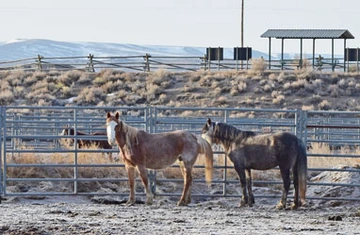
Figure 6. Wild horses in a Wyoming, USA, temporary holding facility.
Jacob Hennig

